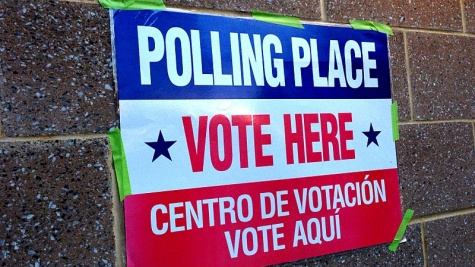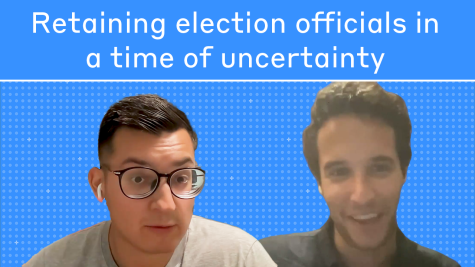A Field Experiment to Examine States’ Efforts to Increase Registration & Turnout
The MIT Election Data and Science Lab helps highlight new research and interesting ideas in election science, and is a proud co-sponsor of the Election Sciences, Reform, & Administration Conference (ESRA).
Lisa Bryant and Michael Hanmer recently presented a paper at the 2018 ESRA conference entitled, “A Field Experiment to Examine States’ Efforts to Increase Registration and Turnout.” Here, they summarize their analysis from that paper.
The Electronic Registration Information Center, or ERIC, is a sophisticated data matching tool that provides state election officials with actionable information about the eligible voters within their states. The Center was formed by seven pioneering states in 2012 with the support of The Pew Charitable Trusts (Pew). Since then, ERIC’s ranks have swelled to 23 states and the District of Columbia. Participation is voluntary, and the Center is wholly owned, managed, and funded by the member states.
States that choose to participate can securely compare their voter registration records and other key state data (such as motor vehicle records,) against the records of other states, as well as U.S. Postal Service data on moves and Social Security data on deaths. Through ERIC, participating states receive reports about voters on their rolls who appear to have moved, died, or recently become eligible to vote. The states then contact the eligible individuals with specific instructions on the most convenient and secure way to register or update an existing, but outdated registration. To date, ERIC has identified, and the states have contacted, more than 26 million eligible American citizens who had not yet registered to vote.
In order to maximize the impact of the outreach from the states, Pew commissioned a series of experiments to evaluate ERIC’s performance and to test the most effective means of contact to voters. The research presented in our paper focuses on Pennsylvania in 2016 and is part of the final round of experiments in this series.
Prior to the 2016 General Election, the Pennsylvania Department of State (PA-DOS) partnered with researchers at the University of Maryland, California State University, Fresno, and the Pew Charitable Trusts to encourage Pennsylvania citizens who were eligible but unregistered (EBUs) to register to vote. Using data from ERIC, the research team randomly assigned EBUs by household to either receive one of four postcards (treatment conditions) or no postcard (control condition). The postcards were personally addressed 5.5 by 8.5 inch full color cards containing information about how to register to vote. The research team and PA-DOS developed four variations (treatments) of the postcards, each one incorporating different tools to encourage voter registration. In accordance with state law, residents of Lehigh, Berks, and Philadelphia counties received bilingual versions of these postcards that included information in both English and Spanish.
To examine whether the timing of contact influenced the rate of registration, the postcards were mailed in two waves, one starting on September 15, 2016 and another starting on September 27, 2016. In keeping with the goal of contacting as many individuals as possible, the research team assigned 95% of EBUs to receive one of the postcards, leaving 5% in the control condition. In total, the PA-DOS sent out 2,277,493 postcards, making this one of the largest, if not the largest, state-led voter registration drives to date.
After the election, the research team matched the ERIC data to the Pennsylvania voter file to evaluate the effect of the postcards on registration and turnout. This then allowed the team to compare differences in the rates of voter registration and turnout across the control and treatment conditions.
Our analysis shows that 7.3% of EBUs in the control condition registered, while 8.3% of those who received any postcard did so. While it may seem small, this 1 percentage point effect is a statistically significant (p<0.001) increase in registration. More importantly, given the high degree of competitiveness in the 2016 presidential election, and particularly in Pennsylvania, which was a key battleground state that was host to extensive campaign activity, the effect is substantively large.
In terms of the number of registrants, we estimate that nearly 24,000 fewer EBUs would have registered if the PA-DOS had not sent out the postcards. As noted earlier, the PA-DOS sent out 2,277,493 postcards. Among those who received a postcard, 189,785 registered to vote. Applying the registration rate of 7.3% from the control condition suggests that 166,047 EBUs would have registered in the absence of the postcards. Subtracting 166,047 from 189,785 gives us the estimate of the number of registrants added to the rolls as a direct result of having received a postcard from the PA-DOS. We did not find discernable differences in the effect of the postcards on registration across the 4 versions or across the 2 waves (however, due to printing delays we did not have as much time between waves as we had hoped).
Our analysis also shows that overall, those who received a postcard were more likely to turn out. That is, turnout in the treatment condition was 6.24%, or 0.88 percentage points higher, than the 5.35% turnout rate in the control group. This effect is statistically significant at p<0.001. This nearly 1 percentage point increase is relatively large given the low overall rates of participation among EBUs, and in the context of previous use of postcards to encourage participation. Again, the turnout effects did not vary much across the 4 versions of the postcards or across waves.
Overall, the efforts of the PA-DOS were successful in increasing registration and turnout. Being contacted by the PA-DOS — not when or with what message — is what mattered. This suggests that going forward, the state can focus on simple postcard designs that will help streamline the process of contacting EBUs.


